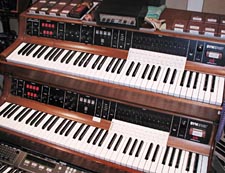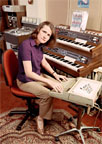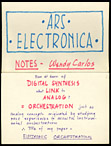|
|
|
|
Secrets of Synthesis --ESD 81692
Another deluxe fully-restored editionOptimum 20-bit Hi-D transfers from the original master mixes, cleaned and tweaked to a fare-thee-well. This is the best this album has ever sounded.
|
1}
INTRODUCTION: (See original liner note for music sources, footnotes a through i) |
 |
At least it doesn't seem all that long ago since
Secrets of Synthesis was first assembled and recorded. I well
recall how it slowly came together. By 1986 it had evolved into an
ideal project to complete my long contract with CBS/Sony, a fitting
summary of what had been learned in the process. I'd been with that
behemoth of a company since my first solo album, the one that was
akin to Leonard Nimoy falling into his Mister Spock rabbit hole. In
my case it was an "S-OB" of a rabbit hole, but just as hard to shake
as Nimoy's.
As the contract years slipped along we'd found ways to expand into
other music besides the great J.S. Bach, and eventually beyond the
Moog Synthesizer, too. That the earliest albums were realized with
Bob Moog's precocious if limited electronic instrument, demonstrates
the way random events and luck play a major role in our lives. Prior
to my involvement with Bob, I'd always planned to assemble some kind
of custom electroacoustic device. My idea took the form of a rack of
oscillators, filters, modulators, and a keyboard, wired together as a
real electronic musical instrument. I collected notes and sketches
over several years, during and after college and graduate school.
And what does a composer who is more of an audio tinkerer than
electronics engineer plan for in the electroacoustic field? There
were several choices. Upon graduation I'd lost my all-night slot at
the music studio on campus, and was left without any means of
creating my musical projects, for exploring new sounds and media. If
you have little money and fewer connections, you study your options
carefully, and probably decide a do-it-yourself approach makes the
best sense. You check out any related kits that may be available, and
begin to save for something like that.
In the early '60s I learned of two electronic instrument kit
builders: Artisan and Schober. Each company manufactured a line of
versatile, better than average electronic organ components, which
suited me fine, as I wanted to custom configure everything. These
were real musical instruments, although I would not be building an
organ. I gathered their literature and catalogs, and found a few
places to try out some of their finished models. Yes, they could be
adapted to less organ-like sounds, something new and abstract.
After meeting Bob Moog, I learned of his new line of synthesizing
equipment. His synths were an unknown, far less proven than Artisan
and Schober equipment. But I liked the idea of a modular approach to
sound design. It was the familiar way we worked at the pioneering
Columbia Princeton Electronic Music Center (CPEMC). Vladimir
Ussachevsky had turned that unwieldy assembly of electronic audio
processors into something much more like a musical instrument.
The custom electronic organ parts would need modification to allow an
open-ended control of new kinds of sound. Moog's modules straddled
both the organ metaphor and the existing electronic music studio. Bob
was also easy to work with, knew a lot about music, and I wanted to
work with him. As with most new technologies, you could be sure
whatever we did would be "obsolete" all too soon. But it sounded like
some fun along the way. So it was that the Moog synth, rather than
something by Artisan or Schober, became so identified with
electroacoustic music, and indelibly tied to my early career.
For a decade I produced new music with analog synth equipment. Early
on I'd run into the many limits, and spent enormous energy and time
in trying to expand the surprisingly narrow sound range in clever
ways. A lot depended on traditional skills of orchestration, which
I'd studied in depth at Columbia. Often it was a matter of "sleight
of hand", some sneaky studio tricks. Once you know your weakest
links, you have the chance to work around them. Already by 1973 I'd
grown increasingly frustrated by what I could not do with the early
synths. That lead to a return to electronic organ devices. My
producer, Rachel Elkind, and I stumbled upon an ideal choice, the
Yamaha Electone E-5, at Ostrovsky's Piano showroom right behind
Carnegie Hall.
We used it on several albums, starting with Switched-On Bach
II. I performed all those natural sounding harpsichord cadenzas
on the E-5, since the Moog synth could never have done them. We found
the E-5 most helpful in a few short film scores we composed for
UNICEF. Inevitably, by the end of the 70's even these new wider
constraints got the best of us. Rachel decided to leave the music
production field. I moved towards where I had been heading all along:
original composition. I wanted to find ways to get back to basics,
and it was time to move on.
The work with early synths proved to be a marvelous learning
experience beyond my formal studies. Bits of knowledge seemed to
stick together neatly. They soon defined a new field, something that
should be called "Electronic Orchestration." I'd been invited to give
a paper at the Audio Engineering Society around this time. So I
turned it into a chance to formalize and expand on my grab bag of
accumulated "stuff." That led to two more lecture demonstrations on
the same topic, including a keynote at the 1980 Ars Electronica
convention, in Linz, Austria...
(Read the complete notes in the Secrets of Synthesis
CD booklet and Enhanced CD files, as explained next.)
--Wendy Carlos
|
Important
Note: In summary, for the
full new
notes, open the pdf file:
|
About the cover: Just before working on Secrets of Synthesis we'd asked our favorite photographer, Vernon Smith, to stop by the studio for a new photo session. We included several informal shots of me at work with the then new Synergy synthesizers, using a medium format camera. Among the negatives was the one that made it past Sony's album cover department people, once their own ideas failed badly. This photo is ours, and we are pleased to offer it to you again as the cover of our new remastered edition. Like the audio, it has been carefully scanned and polished to look better than ever before.
 |
For the past seven or eight years I've given occasional
talks and demonstrations of "Electronic Orchestration" on both coasts
and in Europe. These have been mostly unscripted and informal
affairs, combining many brief musical examples with the spoken word
in a quickly paced presentation.
Each time the question has come up: "Why don't we make this
sort of thing available on a commercial recording?" Associates and
friends in the business have been patiently trying to convince me
that I really ought to do just that. It would also satisfy the
thousands of similar requests that we've received ever since "S-OB"
seemingly erupted onto the music scene back in 1968. For all of you
who cared enough to ask for explanations of "how it all was done," or
"inside tips" and the like, this record is my attempt to answer your
requests. I hope you enjoy it!
--Wendy Carlos
The music is taken from these albums by Wendy Carlos:
(a) "Switched-On Bach"
(b) "The Well-Tempered Synthesizer"
(c) "Sonic Seasonings" (2-CD set)
(d) "Clockwork Orange"
(e) "Switched-On Bach II"
(f) "By Request"
(g) "Switched-On Brandenburgs" (2-CD set)
(h) "Tron" (Soundtrack Album)
(i) "Digital Moonscapes"
All other music cues not listed above composed / arranged and performed by Wendy Carlos
(a) through (g): Produced by & in collaboration with Rachel Elkind-Tourre
(h) and (i): Produced by Wendy Carlos
 |
We've been asked by many of you how
Secrets of Synthesis came to be,
in the final form as heard on our deluxe ESD remastering. It was not
clear how one composer was able to harness the power of this new
technology so seamlessly into a professional recording studio, and
many musicians and fans insisted on learning more of the behind the
scenes of Wendy's music. So several demonstrations were planned and
carried out in an attempt to explain some of the very novel musical
and technical means which were still evolving at the time.
So the collection of ideas and examples you'll hear on Secrets
was not originally created with an album release in mind, but grew in
several stages over lecture demonstrations given formally at the
Audio Engineering Convention in New York City, at informal
presentations in several US cities, and at a feature lecture for Ars
Electronica, in Linz, Austria. The latter convention, given by Wendy
in September of 1981, was quite elaborate. In order not to forget any
major points during the lecture, which was delivered without reading
from a written speech, Wendy used a stack of note 4" x 6" note cards,
the two first of which can be seen stacked in the snapshot above.
Fortunately these had been saved and were still in clean shape.
For our definitive release, as a featured bonus, we've scanned
all of the Ars Electronica cue cards, and have included the complete
set within the Enhanced-CD files for this new edition of Secrets.
Many of you will enjoy reading the notes and compare the way that the
ideas matured in a ten-year transition to demonstration album. This
particular lecture was given around the middle of that decade, so
represents an in-between stage of development. Many of the musical
selections from this stage were also included in the Secrets of Synth
album, although reworked to professional album standards while other
new cues became added. By following the pen colors on the cues seen
on these cards you'll see how the music was interleaved between
spoken commentary. Several slides (images you'll find on our website)
were taken and shown near the beginning, to let the audience see the
studio and several score page examples.
Secrets of Synthesis was recorded originally on both 8-track 1" and 16-track 2" tape machines using Dolby A, then mixed to Dolby premasters on four-track 1/2" Ampex and Sony PCM-F1 digital recorders. The edited final version was then reduced to two track stereo digital masters using equalization and level optimization appropriate to the LP technology of the day. Several selections and the recorded narration were recorded directly to two tracks on both analog and digital recorders. For this new edition we began with the first generation premasters. This meant we could make an optimum Hi-D 20-bit transfer without compromise. The tracks were fine-tuned, cleaned and optimized, as with the other ESD masters in this series. You may rest assured that this is the best these recordings have ever sounded.
This
Special Edition of Synthesis
was assembled by Wendy Carlos. Graphics mix and layout by Drew
Miller; all texts and images by the composer. Photo of Wendy Carlos
by Venon Smith.
Remastered by Wendy Carlos,
with thanks to John
Romkey and Mike Burg, for computer equipment and frequent support, to
Eric Klein for Bias Peak and Waves software, to Joe Winograd and
Gabriel Lawrence @ Aris for MusiCode support, to Drew Miller@ ESD for
the Enhanced-CD file assembly and HTML editing, and to ESD's Rob
Simonds for thoughtful suggestions, feedback, and executive
support.